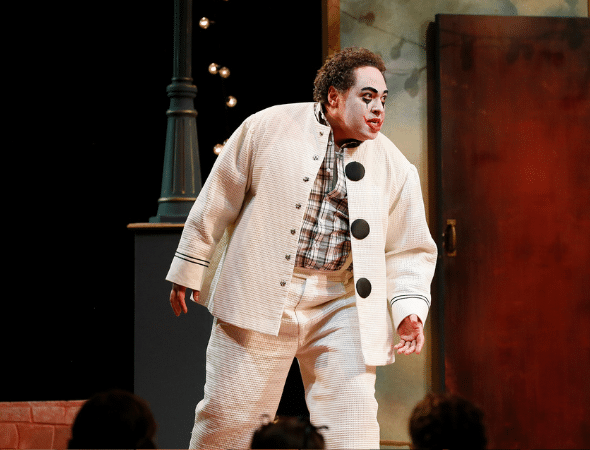Commedia and Reality
by Paula Fowler
Nowhere today can we experience commedia dell’arte performances the way audiences did in Italy 400 years ago: itinerant outdoor acting troupes came into town, set up an outdoor stage, hawked miraculous potions, and “drummed up” an audience with an actual drum to send the message that the actors were in town. Then, when the commedia began, the audience would recognize the elaborately-made up or masked characters as simplified human types. During the play, these characters would get all tangled up in a conflict, and there might be some regular lazzi (sight gags) and acrobatics, as well as the “slap-stick” sounds of Harlequin’s split bat with which he threatened violence. Eventually, the conflict would be worked out through a lot of bawdy, raucous action to a comedic ending.
The popular commedia characters included Harlequin, the clever servant whose costume featured multi-colored diamonds and who yearned for Columbina, the clever lady’s maid who juggled many suitors. A third, Pagliaccio, the clown, was one of her suitors, but he always found his love unrequited. His oversized white shirt with its pom-pom buttons were large because they were hand-me-downs, an indication of his status as the youngest son.

Commedia dell’arte no longer thrived at the end of the 19th century, when Ruggero Leoncavallo, a contemporary and rival of Puccini’s, elected to make it central in his opera Pagliacci. After the success of Mascagni’s one-act Cavalleria rusticana, Leoncavallo put himself to the task of writing a “verismo” (truth, reality) opera of his own, “verismo” being the term to describe the kind of story popular at the end of the 19th century that dealt with life and love as experienced by real people, full of painful, often violent conflicts. In literature, this movement was called “naturalism;” both styles are infamous for digging into the dregs, wading audiences through the muck, and then ending pessimistically.
Commedia’s blatant artificiality (its stock characters and large gestures) aided Leoncavallo, ironically, in his exploration of verismo in Pagliacci. He concocted a plot of multiple levels of distance from reality: at the center is an actual commedia about a disastrous love triangle. Surrounding that performance is the backstage story of the personal lives of actors in the commedia, the troupe that travels from town to town performing for communities—in the case of this performance, for a town composed of the opera chorus. Leoncavallo presses further by adding another layer, closer to our reality: the actor Tonio begins the opera by stepping in front of the curtain and directly addressing us. And of course, there’s one more level because Tonio is played by an opera singer from our real world, and he is performing a role while pretending he’s not.
In his opera-opening speech, Tonio claims that what we’re about to witness is not just a play, but a real story with characters who have real feelings: he suggests there’s no difference between the drama we see on the stage and what goes on in real life. The opposite stance in this argument is presented by Canio, another Commedia actor, the one who plays Pagliaccio, the clown. Canio claims that “life and theatre are not at all the same thing.” “Onstage, if Pagliaccio should catch his wife with another man, he just gives them a funny scolding, or else they beat him up—and the public laughs and applauds.”
The opera takes us on a journey that proves Tonio correct. Canio himself recognizes that the love triangle in the commedia resembles his own experience with his wife Nedda and her lover Silvio. Canio proceeds from that realization to blur the barriers between levels of reality when he charges into the crowd watching the commedia to kill both his wife and Silvio.
It’s some kind of cherry-picking proof when a theatrical work presents a thesis about reality, and then its creators choose to prove it with the action they select. The question for us, I suppose, is to decide whether the evidence is compelling enough for us to accept the premise presented for our consideration. Then, under Leoncavallo’s tutelage, we may start always looking for reality whenever we watch a made-up story on stage, even in the most contrived of performances.
Paula Fowler is the former Utah Symphony | Utah Opera Director of Education & Community Outreach. She has been writing opera commentaries for Utah Opera for more than 20 years.





